1872: The Fortune of War Tragedy: A Christmas Celebration in Tanjong Pagar Turns Violent
Through news reports run in the Singapore Daily Times, Lee Kong Chian Research Fellow Erik Holmberg pieces together the events leading up to the violence and bloodshed in a tavern during a 1872 Christmas celebration.1
“A very serious affray occurred last night at a tavern called the ‘Fortune of War,’ on the corner of Tanjong Pagar and New Harbour roads, between some men of the 80th Regiment from the steamer Scotland, and some sailors belonging to that vessel.… a patrol of soldiers, with sidearms, was sent out from the ship to look for stragglers, but the attractions of the tavern, and the fact of it being Christmas, proved too great for them, and the patrol remained there, drinking with the sailors and others, until a late hour, when, as usual when sailors and soldiers meet at a drinking bout, the entertainment wound up with a fight. The soldiers used their bayonets, and the sailors their knives and anything else they could get hold of. One of the sailors was killed, we believe with a bayonet wound in the abdomen, and there were several wounded on both sides.”
— Singapore Daily Times, 26 December 1872
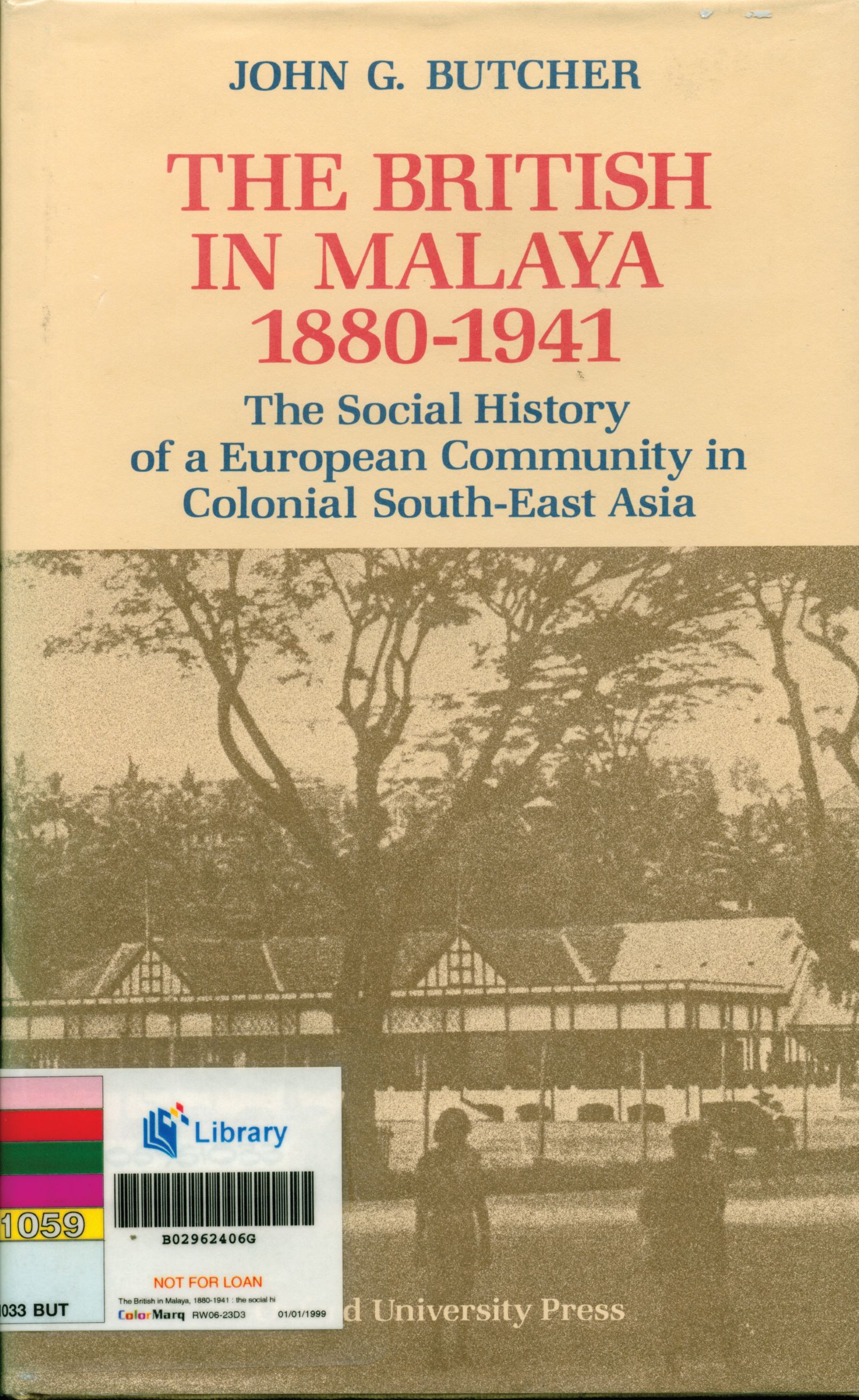
While exploring the history of public celebrations in colonial Singapore, I happened to find an account of a Christmas celebration in 1872 which sadly degenerated into a tragic and violent incident. By piecing together the news reports that appeared over several months in the pages of the Singapore Daily Times, it is possible to reconstruct an account of violence and bloodshed in a tavern and its judicial aftermath, as well as certain aspects of the social and criminal context within which this story played out.
It is a story that reads like something out of the lore of the Wild West of the American frontier, rather than what one might expect to find in the history of Singapore, which is today a city-state internationally renowned for its orderliness and safety. This forgotten tragedy in 1872 provides insights into a little-known aspect of the social history of colonial Singapore: the lifestyle and recreational activities of European soldiers and sailors, their presence on this island, the nature of their criminal activities, and the responses of the colonial authorities and the local press. These insights may help to provide a more balanced view of the society of colonial Singapore, and help to clear up some possible misconceptions about this society that may exist in the present day.
Today, when we think of Europeans in the colonial settlement of Singapore, we may imagine wealthy people who lived in mansions, where they were attended by servants. However, not all Europeans in the settlement were wealthy and privileged; in fact, it is practically certain that most of them were working-class soldiers and sailors, whose natural habitats included taverns and the less reputable streets and alleys of Singapore, rather than sumptuous mansions in fashionable suburbs.
Likewise, when we think of rioting or other violence in colonial Singapore, we may think of gangs of Chinese samsengs (gangsters) who belonged to secret societies, fighting in the streets.2 However, Chinese secret society members were not the only offenders who committed acts of violence here. Not all the Europeans here were respectable law-abiding inhabitants of the settlement, and violent crimes committed by Europeans were not unknown. Indeed, the number and variety of crimes committed by Europeans in Singapore in late 1872 and early 1873 is sufficient to suggest that European criminality was a significant component of the overall criminality in this settlement, and hence a feature of the local social history of crime which must not be overlooked in the study of Singapore’s social past.
The respectable side of the Western presence in the settlement has been conspicuously commemorated in the statue of Raffles, in the names of Raffles Place and Raffles Hotel,3 in all the other streets and places named after prominent Westerners, and in the mansions that were the homes of wealthy Europeans, some of which still stand today. However, the involvement of some Westerners on the disreputable side of life in colonial Singapore was, quite naturally, never commemorated with monuments, for obvious reasons.4 There was evidently a belief among the British elites in the colonial era that the presence of poor or unemployed Europeans in Singapore and Malaya was an embarrassment which posed a threat to European prestige. Moreover, they felt that their prestige had to be sustained at all times, since it was regarded as essential to the colonial system here.5 John Butcher has explored this topic in detail in his book The British in Malaya, 1880–1941: The Social History of a European Community in Colonial South-East Asia.6 Nevertheless, there was a presence of working-class Europeans in colonial Singapore, and it is the task of the social historian to explore such forgotten elements of this society, in order to achieve a better understanding of the social history of this place.
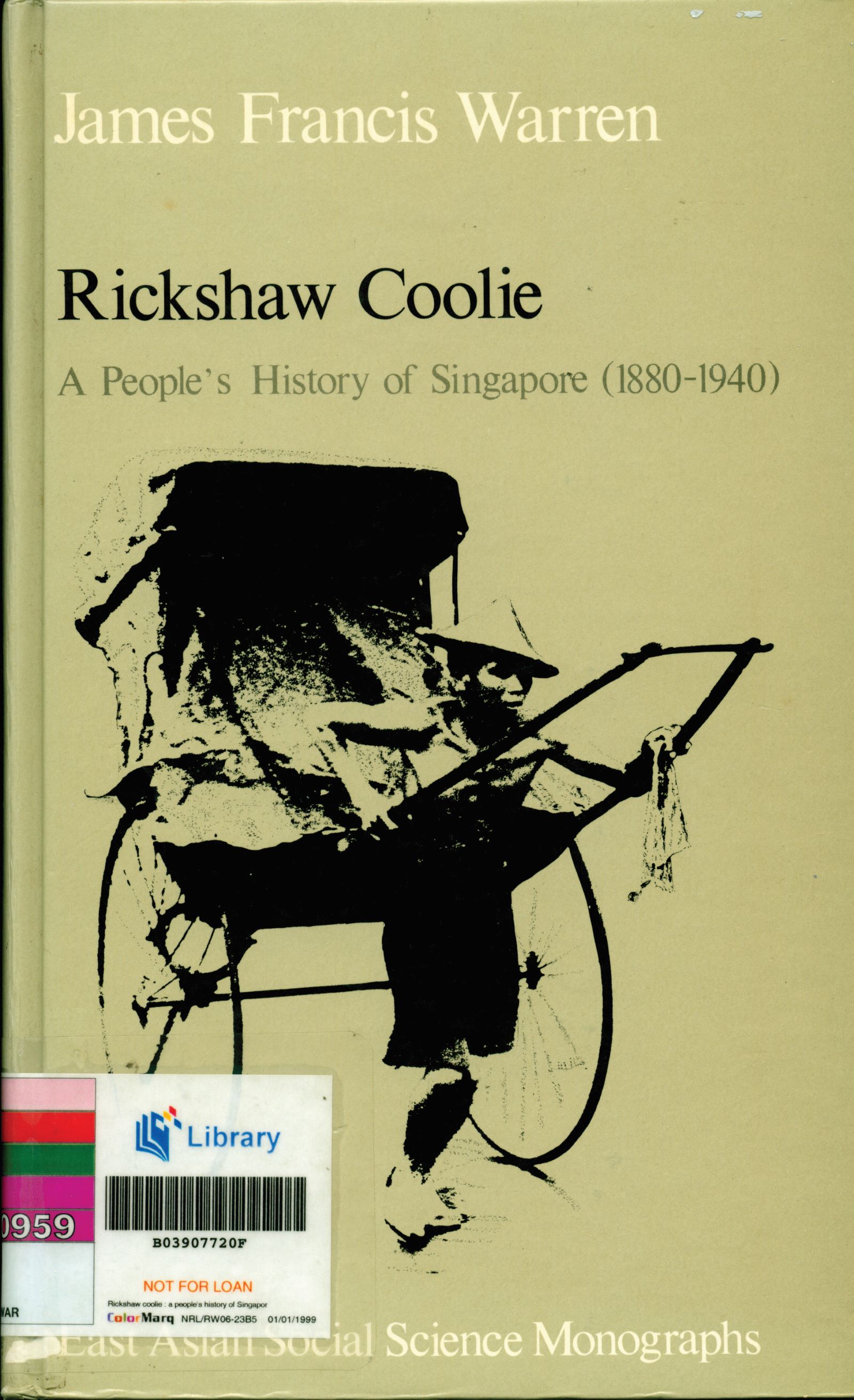
The work of prominent historians on the social history of Singapore and Malaya has inspired this exploration of celebration, crime and death in Tanjong Pagar in 1872. James Francis Warren has shown how historical research can recover and retrieve the experiences and lives of largely forgotten people7 in his classic studies of the social history of rickshaw pullers and prostitutes: Rickshaw Coolie: A People’s History of Singapore (1880–1940) and Ah Ku and Karayuki-san: Prostitution in Singapore 1870–1940. John Butcher has described the situation of non-elite Europeans in Malaya, including working-class train drivers and unemployed rubber planters, and also analysed the significance of a well-known European murder case, in his book The British in Malaya, 1880–1941: The Social History of a European Community in Colonial South-East Asia.8
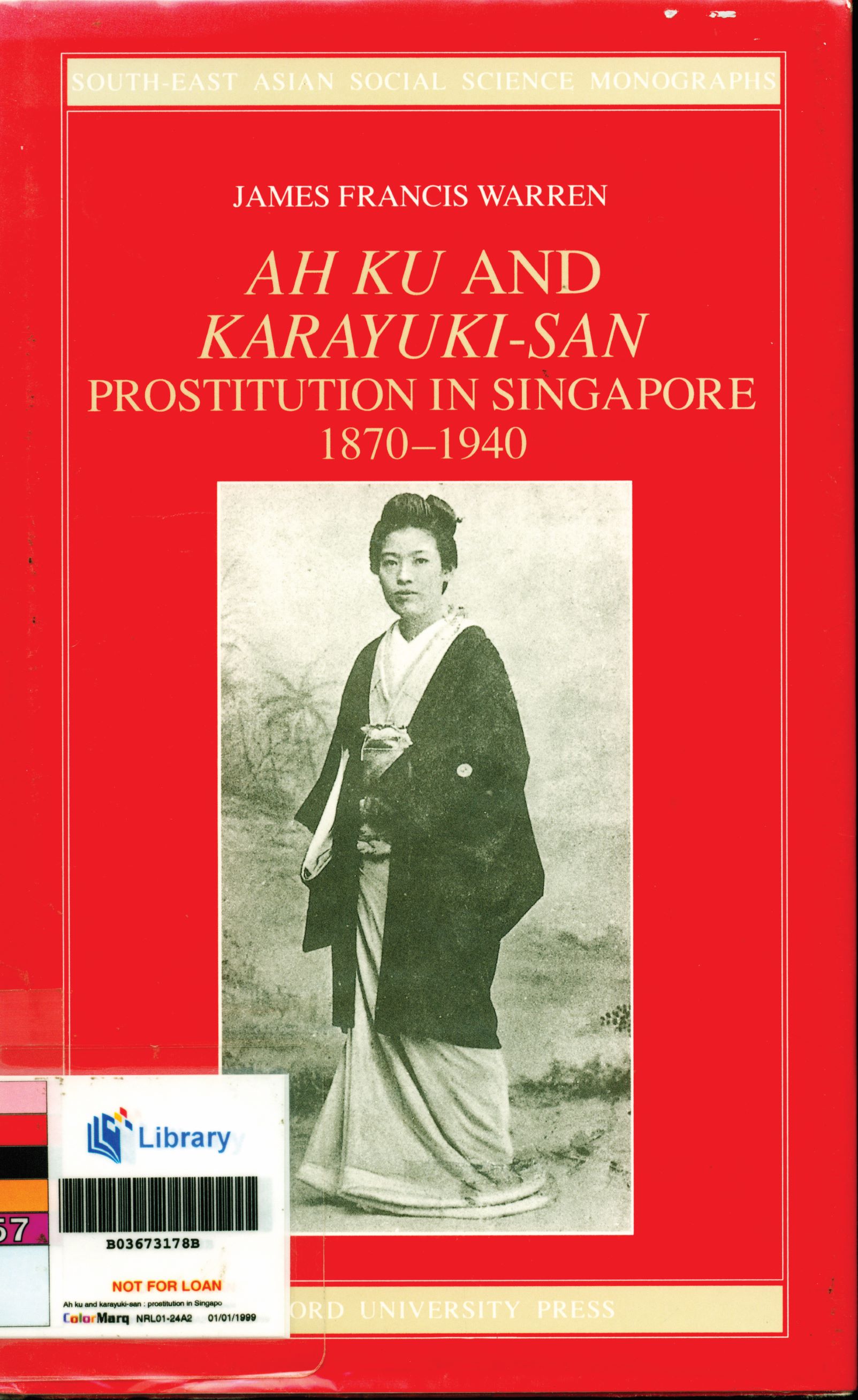
The lives of Chinese immigrant labourers, including their experiences in China which motivated them to leave their homeland, the process of emigration and the social problems which they experienced in Singapore and Malaya, have been vividly depicted by Yen Ching-hwang in A Social History of the Chinese in Singapore and Malaya 1800–1911.9 While Chinese immigrant labourers comprised the bulk of the labouring-class population of Singapore in the 19th and early 20th centuries, we should not forget the other, less numerous sections of the working-class population, including those who were from Europe.
Yuletide Celebration and Tragedy
The setting of the bloodshed on Christmas Day in 1872 was a tavern called the “Fortune of War” in Tanjong Pagar, in an insalubrious swampy locality near the harbour, which seemed to have been devoted at least in part to the refreshment of seafarers. We can imagine what this area was like in the 1870s, thanks to a description of the place written by a visitor who landed here five years after the deadly Yuletide brawl. When the American naturalist William Hornaday arrived in Singapore on 20 May 1878, he described a stinking creek of slime along the road between the harbour and Chinatown, and he noted several taverns with nautical names in this area.10 The imagery of Tanjong Pagar in the 1870s that Hornaday thus bequeathed to us – an image of seafarers’ taverns and a slimy, reeking stream – sets the stage for the picture of holiday celebration and deadly violence that emerges from the microfilmed pages of the Singapore Daily Times.
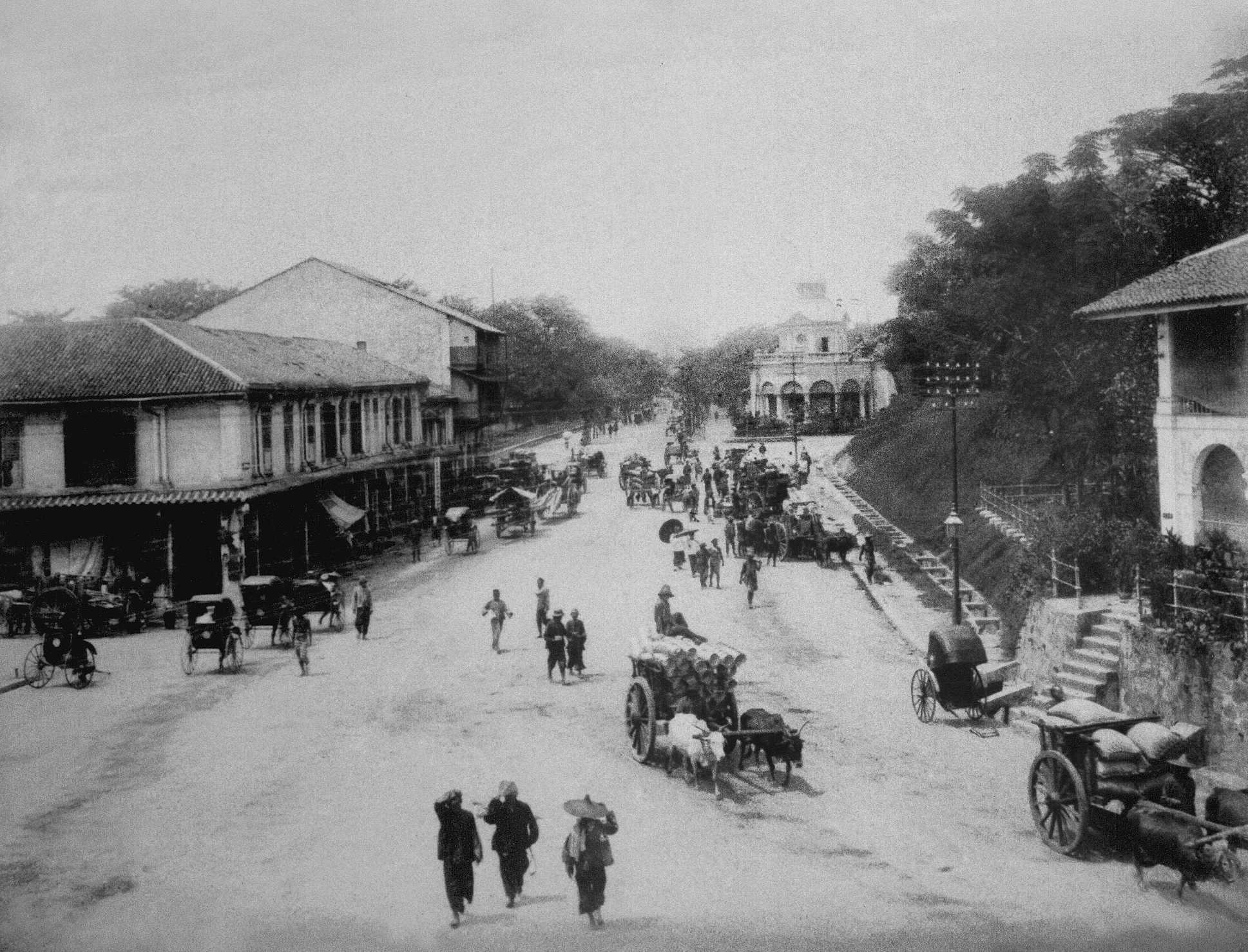
The first of several reports on the bloodshed at the Fortune of War tavern on the night of Christmas in 1872 appeared in the Singapore Daily Times on the following day. This account explains how the soldiers and sailors happened to engage in what seemed to have been a friendly Christmas celebration together, complete with alcoholic refreshments, before the party turned ugly. The report goes on to recount how the men in the tavern attacked and wounded a European police officer when he tried to stop the brawl, and how reinforcements finally arrived and brought the situation under control.
In the words of the Singapore Daily Times: “A very serious affray occurred last night at a tavern called the ‘Fortune of War’, on the corner of Tanjong Pagar and New Harbour roads,11 between some men of the 80th Regiment from the steamer Scotland, and some sailors belonging to that vessel. There was, we hear, a fight between a sailor and a soldier in the afternoon at this tavern, which resulted in the arrest of the parties. In the evening, a patrol of soldiers, with sidearms, was sent out from the ship to look for stragglers, but the attractions of the tavern, and the fact of it being Christmas, proved too great for them, and the patrol remained there, drinking with the sailors and others, until a late hour, when, as usual when sailors and soldiers meet at a drinking bout, the entertainment wound up with a fight. The soldiers used their bayonets, and the sailors their knives and anything else they could get hold of. One of the sailors was killed, we believe with a bayonet wound in the abdomen, and there were several wounded on both sides. There are two men, a soldier and a sailor, lying wounded on board the steamer, and two or three others in the hospital. The police arrived while the fight was going on, and Corporal Barrow, a European police officer, while endeavouring to make arrests and stop the row, received two or three bayonet scratches and was pretty well beaten. Reinforcements arrived, however, and a number of combatants were arrested, and several others were taken into custody this morning from on board the steamer for having been concerned in the fight. Among the trophies secured by the police are, an old-fashioned cutlass covered with rust, and with spots of blood on it, – a jack knife with a pointed blade about four inches long, and a heavy iron belaying-pin. The police are inquiring into the affair, and an inquest will be held on the body of the sailor who was killed.”12
Aftermath
The Singapore Daily Times later continued the narrative of the incident at the Fortune of War tavern, picking up the story where it left off with the arrival of police reinforcements and the arrest of the perpetrators, and detailing the removal of the dead sailor to the hospital and the subsequent autopsy. Surprisingly, it appeared that the sailor actually died as a result of one or more persons stepping on him, rather than from his multiple wounds. It would seem that the immediate cause of the sailor’s death might have been a boot, rather than a bayonet. The Singapore Daily Times reported: “After the fight, the man was picked up and taken to the hospital, but he died before reaching there, – in fact he died immediately. In this case, it was most extraordinary that though the deceased man had no less than ten bayonet and contused wounds on his body, Dr. Hampshire, who made the post-mortem examination, would be able to tell them that not one of these wounds was sufficient to cause death, but that death was caused by the rupture of an artery, which was very probably done by his being trampled upon. There was, however, the probability that the man was stunned by one of the wounds he received, which caused him to fall.”13 Thus, the sailor was apparently knocked to the floor of the tavern, whereupon one or more persons trampled or stomped upon him so severely that one of his blood vessels burst open and he bled to death.
What do these two accounts of the brawl reveal about the newspaper and its readership? The description of the violence, the weaponry, the injuries and the precise cause of the dead sailor’s exsanguination could all be indicative of the interests of the readership of the Singapore Daily Times, or at least the editor’s perception of the readers’ interests. What is perhaps more interesting, however, is a rather important detail which was omitted from both reports: the dead sailor’s name. The names of the soldiers who participated in the brawl were, however, published in the newspaper. According to the Singapore Daily Times: “Ten soldiers of the 80th regiment, named John Langman, Thomas Lovegrove, John Thomas, William Harrison, Hans Wilson, Partridge Farrar, James Walker, William Dyball, William Hanna, and Isaac Wooden, who were engaged in the fight at the ‘Fortune of War’ tavern on Christmas night, were on Tuesday [31 December 1872] committed by Captain Walshe, Police Magistrate, to take their trial at the next criminal session on a charge of ‘Culpable Homicide’.”14
The grand jury was empanelled at the Court House on 6 January 1873, before Chief Justice Thomas Sidgreaves. By 10 January 1873, the grand jury had found cause to charge eight of the 10 soldiers with two counts of indictment: a “count for culpable homicide not amounting to murder” and a “count for culpable homicide not amounting to murder by causing bodily injury likely to cause death”. The grand jury did not find cause to charge two of the soldiers, namely Hans Wilson and Isaac Wooden.15 The remaining eight soldiers were soon tried, convicted and sentenced, as announced by a one-sentence report in the Singapore Daily Times: “In the case of the eight soldiers of the 80th, tried on the 20th January, for having caused the death of a sailor at the ‘Fortune of War’ tavern on Christmas night, the jury found the prisoners guilty on the second count, for rioting, and the Sergeant, John Langman, was sentenced to two years, and the other seven to nine months, rigorous imprisonment.”16
Concluding Remarks
The violent death of a sailor at the Fortune of War tavern – together with various other criminal activities that took place around the same time – highlights the multiracial nature of the underclass of colonial Singapore circa 1872. While this essay has focused on the criminal activities of soldiers and sailors who were likely members of the British working class present in colonial Singapore, it should not be forgotten that there must have been many other British soldiers and sailors who were law-abiding and who, therefore, left even fewer footprints in the historical record.
The same must certainly have been true with regard to the Chinese who made up the majority of the working-class population, as well as the Indian and Malay inhabitants of colonial Singapore. Most of them must have been law-abiding, and therefore less visible historically, if not actually invisible, in the historical narrative. After all, if most of the Asian working-class people were not basically law-abiding, then the settlement would have been totally ungovernable. Indeed, it would have descended into total chaos, which would have been contrary to the interests of local Asian elites and European elites alike. Yet, given the limited information available for law-abiding working-class people in Singapore in the early 1870s, we may thus be left to rely largely upon the records of their law-breaking brethren, Asians and Europeans alike, with which we can try to gain some sense of the nature of colonial working-class life on this island.
It might not be too much of an exaggeration to conclude that the lives of working-class Asians and Europeans in colonial Singapore are largely invisible in the historical record, except for when they engaged in criminal activities and, in some cases at least, when they died. James Francis Warren has shown how the Coroner’s Records of colonial Singapore, which are available for the years from 1883 to 1940, can shed a great deal of light on the lives and deaths of working-class people, by providing historians with rich sources of information.17 For the years prior to 1883, the crime reports published in the local newspapers may help to fill in some of the gaps, as the preceding pages have endeavoured to demonstrate. Fortunately, the newspapers are available on microfilm in the Lee Kong Chian Reference Library in the National Library Building.
Asians and Europeans alike were well represented among both the most respectable and the most disreputable elements of this colonial society, and probably at every social stratum in between. These facts drive home the point that the cosmopolitan population of this island was characterised at least as much by class divisions as it was by racial identities, and that these class divisions transcended the racial and ethnic categories within the population. Asians and Europeans alike were members of the underclass and the working class here, as well as the middle class and the elite class.18
Studies of the social history of colonial Singapore (and probably of other colonial societies as well) should endeavour to avoid the temptation of simplistically reducing or essentialising the local population and its experiences into racial or ethnic blocs. To echo a point which David Cannadine has made in his book Ornamentalism, the concept of class was at least as important as race within the history of the British Empire – and this may well have been true with regard to other empires, too.19
At the top of the social hierarchy of colonial Singapore was a multiracial elite class, within which political power was officially controlled by a few Europeans, but the bulk of the wealth and property was apparently controlled by Asian elites. At the base of the social pyramid was a multiracial underclass which included European soldiers and sailors, as well as Chinese labourers and Malay and Indian policemen. The criminal element within this underclass was kept in check by the enforcers of the colonial system, including European soldiers and Asian policemen, but some of these uniformed enforcers were themselves prone to violence and crime.
The diverse elements of this colonial society coexisted in an uneasy yet manageable equilibrium that provided the setting for the continued economic and social success of the wealthy Asians and their European co-elites who together comprised the colonial elite class, while the continuity of the economic success of the settlement legitimised the social and political system. The continual, even routine, incidence of violent crime in Singapore provided a constant reminder of the necessity of the colonial state as a bulwark against disorder; and the reliable success of this state in keeping crime and disorder down to a manageable level justified the continuity of the state and contributed to the legitimation of the British Empire.
Most of the Europeans who set foot on Singapore soil during the colonial era must have been soldiers and sailors; indeed, most of the Europeans who lived here for any length of time during that era were probably the British soldiers who were garrisoned here at Tanglin Barracks and other places on this island. Yet most of them left almost no trace in the published histories of Singapore – and, it would seem that they left few footprints in the written records, such as the contemporary newspapers.
Only when they disgraced themselves and dishonoured their professions by committing crimes did they find their way into the newspapers – but even then, their activities and their presence were apparently, for the most part at least, deemed too unimportant or unremarkable to deserve attention in historical accounts, with a few notable exceptions, such as the excellent recent military history of Singapore entitled Between Two Oceans 20 and the personal memoirs of armed forces personnel who served here during World War II.
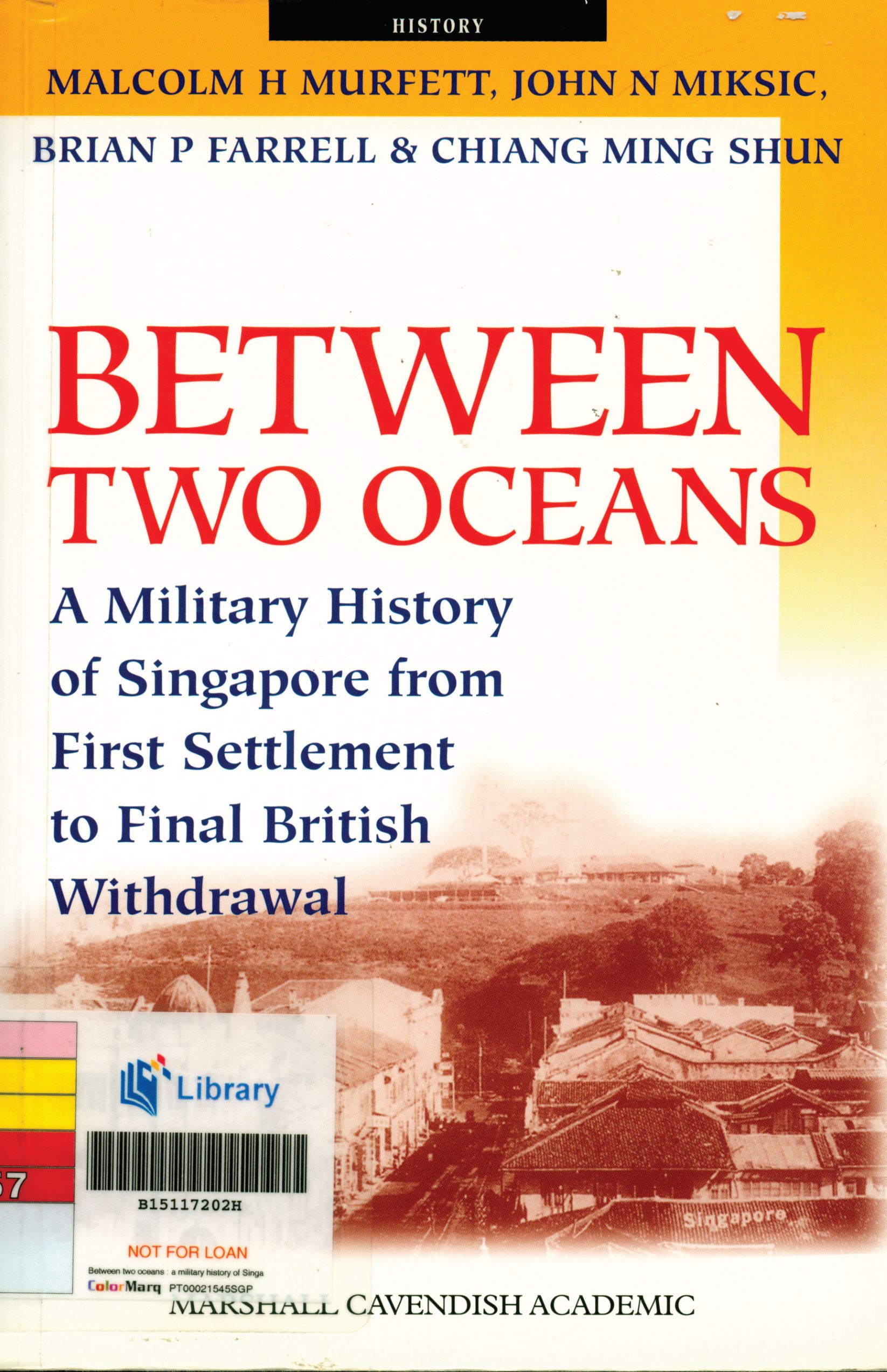
Such exceptions aside, the relatively small number of Europeans who comprised the usual cast of characters in the historical narrative of colonial Singapore was merely a privileged minority within a local European population, which was itself a tiny minority within the mostly Chinese population of multiracial Singapore. According to the 1871 census, this island had a total population of 97,111, including 54,098 Chinese, 19,250 Malays, 9,297 “Klings or Natives of Southern India,” 1,925 “Europeans and Americans,” and 1,414 “Native Prisoners”, as well as “Bugis, Boyanese and others”.21
It was not the skin colour of these Europeans that determined their prominence or absence in the documentary record and the historical narrative, nor was it their nationality; the British soldiers and sailors who brawled in the Fortune of War tavern were likely just as European and just as “white” as any of the Europeans here. What distinguished the Europeans who were remembered from those who were quickly forgotten was their social class or status within the local social structure. Likewise, wealthy local Chinese elites and other Asian elites of the colonial era were (and still are) celebrated and remembered in print and in the names of streets and places, while the working-class masses of the Chinese majority were largely forgotten, at least until James Francis Warren painstakingly recovered the details of their lives from the crumbling pages of the coroners’ records.
An exploration of how the killing at the Fortune of War tavern during a Christmas celebration in 1872 was reported in the local newspaper at the time (together with some consideration of the social and criminal context of this incident) supports David Cannadine’s argument that class divisions were at least as important as racial divisions in the British Empire. Moreover, this case study of celebration and criminality supports the conclusion that much can be learned about the nature of the social history of colonial Singapore from the pages of the local press, and even about the long-forgotten people who lived on the margins of that society.
The image of the European section of the local population which emerges from this research is quite different from the preoccupation with a small group of elite Westerners who comprise the cast of characters in the standard works on Singapore’s colonial history. Instead, this study has uncovered traces of colonial Singapore’s European underclass, allowing a glimpse of an almost totally forgotten aspect of the underside of this colonial society, and showing that even the tiny European population was more socially diverse than we might expect.
The Christmas bloodshed in 1872 reveals the underside of celebratory activity, the potential for violence inherent in the combination of alcohol and weapons, and soldiers and sailors, even at Christmas. Evidence from public celebrations, as from a Christmas celebration in Tanjong Pagar that turned ugly, offers opportunities to learn not only about the activities of elites, but of working-class and underclass people as well. The preceding pages give some idea of the wealth of information on the social history of Singapore which may be found in the Lee Kong Chian Reference Library, where the collections housed within the halls of this futuristic structure contain tragic tales of brutal crimes that were committed when Singapore was a frontier settlement, on a par with the Wild West.
The author wishes to acknowledge the contributions of Dr Ernest C.T. Chew, Visiting Professorial Fellow, Institute of Southeast Asian Studies, Singapore, in reviewing this article.

Lee Kong Chian Research Fellow (2008)
National Library
REFERENCES
Charles Burton Buckley, An Anecdotal History of Old Times in Singapore: From the Foundation of the Settlement … on February 6th, 1819 to the Transfer to the Colonial Office … on April 1st, 1867 (Singapore: Fraser & Neave, 1984) (First ed. Published 1902). (Call no. RSING 959.57 BUC)
David Cannadine, Ornamentalism: How the British Saw Their Empire (London: Allen Lane, The Penguin Press, 2001). (Call no. RCLOS 941.08 CAN)
Edwin Lee, The British As Rulers: Governing Multiracial Singapore 1867–1914. (Singapore: Singapore University Press, 1991). (Call no. RSING 959.57022 LEE)
Ernest C.T. Chew, “The Foundation of a British Settlement,” in A History of Singapore, ed. Ernest C.T. Chew and Edwin Lee (Singapore: Oxford University Press, 1991, third impression 1997). (Call no. RSING 959.57 HIS)
James Francis Warren, Rickshaw Coolie: A People’s History of Singapore (1880–1940) (Singapore: Oxford University Press, 1986). (Call no. RSING 301.4444095957 WAR)
James Francis Warren, Ah Ku and Karayukisan: Prostitution in Singapore 1870–1940 (Singapore: Oxford University Press, 1993). (Call no. RSING 306.74095957 WAR)
John Cameron, Our Tropical Possessions in Malayan India: Being a Descriptive Account of Singapore, Penang, Province Wellesley, and Malacca; Their Peoples, Products, Commerce, and Government (London: Smith, Elder and Co., 1865). (From BookSG; call no. RRARE 959.5 CAM; microfilm NL11224)
John Cameron, Our Tropical Possessions in Malayan India with an Introduction by Wang Gungwu (Kuala Lumpur: Oxford University Press, 1965). (Originally published in 1865). (Call no. RSING 959.5 CAM)
John G. Butcher, The British in Malaya, 1880–1941: The Social History of a European Community in Colonial South-East Asia (Kuala Lumpur: Oxford University Press, 1979). (Call no. RSING 301.4512105951033 BUT)
William T. Hornaday, Two Years in the Jungle: The Experiences of a Hunter and Naturalist in India, Ceylon, the Malay Peninsula and Borneo (New York: Charles Scribner’s Sons, 1885). (Call no. RSING 910.4HOR)
William T. Hornaday, Two Years in the Jungle: The Experiences of a Hunter and Naturalist in India, Ceylon, the Malay Peninsula and Borneo ([Whitefish, MT]: Kessinger Publishing, 2007). (Originally published in 1885). (Call no. RSEA 915.4 HOR)
Singapore Daily Times, 1872–1873. (microfilm NL349 and NL350)
The Straits Calendar and Directory (Singapore: Commercial Press, 1873)
NOTES
-
This article is a condensed version of a longer essay, both of which were submitted to the National Library of Singapore in fulfilment of the requirements of my appointment as a Lee Kong Chian Research Fellow in 2008. I am very grateful to Clement Liew, Assistant Professor Syed Muhd Khairudin Aljunied and Professor James Francis Warren, each of whom inspired me to attempt to retrieve the history of some of the forgotten people of colonial Singapore – including those who sometimes found themselves on the wrong side of the law. I am also grateful to Senior Reference Librarian Nor-Afidah Abd Rahman of the Lee Kong Chian Reference Library for her assistance, and to Deputy Director Johnson Paul, Assistant Director Dr. Narinder Kaur Bawa Singh, Veronica Chee, Pat Ng, Angelina Phoon, Sandy Huey Jing Toh, Akshata Ramchandra Patkar, and the many other people at the National Library who helped me in various ways. ↩
-
Edwin Lee, The British As Rulers: Governing Multiracial Singapore 1867–1914. (Singapore: Singapore University Press, 1991), 23–47. (Call no. RSING 959.57022 LEE) ↩
-
Regarding the founding of the Settlement of Singapore by Stamford Raffles, see, for example: Ernest C.T. Chew, “The Foundation of a British Settlement,” in A History of Singapore, ed. Ernest C.T. Chew and Edwin Lee (Singapore: Oxford University Press, 1991), 36–40. (Call no. RSING 959.57 HIS) ↩
-
In 1986, James Francis Warren pointed out that there was no monument to rickshaw pullers in Singapore. See James Francis Warren, Rickshaw Coolie: A People’s History of Singapore (1880–1940) (Singapore: Oxford University Press, 1986), 326. (Call no. RSING 301.4444095957 WAR) ↩
-
See John Cameron, Our Tropical Possessions in Malayan India: Being a Descriptive Account of Singapore, Penang, Province Wellesley, and Malacca; Their Peoples, Products, Commerce, and Government (London: Smith, Elder and Co., 1865), 281 (From BookSG; call no. RRARE 959.5 CAM; microfilm NL11224); Reprint edition, Singapore: Ascanio Books, 2007 (Call no. RSING 959.503 CAM); Also reprinted as John Cameron, Our Tropical Possessions in Malayan India, intro. Wang Gungwu (Kuala Lumpur: Oxford University Press, 1965). (Originally published in 1865). (Call no. RSING 959.5 CAM) ↩
-
John G. Butcher, The British in Malaya, 1880–1941: The Social History of a European Community in Colonial South-East Asia (Kuala Lumpur: Oxford University Press, 1979), 127–128, 132, 157, 223. (Call no. RSING 301.4512105951033 BUT) ↩
-
Regarding the recovery and retrieval of the lives of prostitutes through historical research, see James Francis Warren, Ah Ku and Karayukisan: Prostitution in Singapore 1870–1940 (Singapore: Oxford University Press, 1993), 389. (Call no. RSING 306.74095957 WAR) ↩
-
Butcher, British in Malaya, 93–96,127–33, 233–38. ↩
-
Yen Ching-Hwang, A Social History of the Chinese in Singapore and Malaya 1800–1911 (Singapore: Oxford University Press, 1986), 1–10, 112–16, 222–58. (Call no. RSING 301.45195105957 YEN) ↩
-
William T. Hornaday, Two Years in the Jungle: The Experiences of a Hunter and Naturalist in India, Ceylon, the Malay Peninsula and Borneo ([Whitefish, MT]: Kessinger Publishing, 2007). (Originally published in 1885). (Call no. RSEA 915.4 HOR); parts III and IV reprinted as: The Experiences of a Hunte and Naturalist in the Malay Peninsula and Borneo, with an introduction by J.M. Gullick, 1993, 3. ↩
-
New Harbour was renamed Keppel Harbour on 19 April 1900, in honour of Admiral of the Fleet Henry Keppel, while the road leading to this harbour was named after Admiral Keppel 15 years earlier, according to Charles Burton Buckley, An Anecdotal History of Old Times in Singapore: From the Foundation of the Settlement … on February 6th, 1819 to the Transfer to the Colonial Office … on April 1st, 1867 (Singapore: Fraser & Neave, 1984), 493. (First ed., 1902). (Call no. RSING 959.57 BUC) ↩
-
Singapore Daily Times, 2 Dec 1872, 2. ↩
-
Singapore Daily Times, 7 Jan 1873, 3. ↩
-
Singapore Daily Times, 2 Jan 1873, 2. ↩
-
Singapore Daily Times, 11 Jan 1873, 2. ↩
-
Singapore Daily Times, 1 Feb 1873, 2. ↩
-
Warren, Rickshaw Coolie, x, 5–8. ↩
-
I refer to classes as working, middle and upper or elite merely because these terms have been widely used, and because I find them useful for explanatory purposes in the current context. I am not arguing that there is a fixed number of social or economic classes, or that the boundaries between different classes are necessarily definite and fixed. However, the concept of class seems to have sufficient social reality to be useful in discussions of societies and social structure, despite the difficulty in finding clear-cut class definitions – indeed, it seems likely that such clear boundaries will never be found, because they do not exist today, at least not in modern industrial or post-industrial societies. Still, the uncertainty over the number and definition of classes within a given population does not prevent us from thinking about societies in terms of class. ↩
-
David Cannadine, Ornamentalism: How the British Saw Their Empire (London: Allen Lane, The Penguin Press, 2001), 9–10. (Call no. RCLOS 941.08 CAN). I am grateful to Associate Professor Maurizio Peleggi for urging me to read Ornamentalism in 2002. ↩
-
Malcolm H. Murfett, John N. Miksic, Brian P. Farrell, and Chiang Ming Shun, Between Two Oceans: A Military History of Singapore From First Settlement to Final British Withdrawal (Singapore: Oxford University Press, 1999), 95. (Call no. RSING 355.0095957 BET) ↩
-
See the report on the census of Singapore Island taken on 3 April 1871, in Singapore Daily Times, 16 May 1873, 4. ↩

